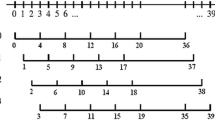Abstract
This research addresses an issue of wide band (WB) speech transmission (having cut-off frequency \(\hbox {f}_{\mathrm{c}}=8\) kHz) over standard narrow band (NB) communication link (supporting bandwidth of 300–3,400 Hz). A long transition time for technological up-gradation from NB to WB systems eventually lead to development of backward compatible techniques such as artificial bandwidth extension (ABE) which is capable of providing bandwidth of 50–7,000 Hz, in turn contributing toll quality recovered speech at receiving end. This paper investigates a novel approach to compute high band (HB) features using linear predictive coding (LPC) technique at transmitter from given input WB speech corpus. These encoded features are embedded into bitstream of proposed GSM Full Rate 06.10 NB speech coder using joint source coding and data hiding technique and then transmitted to receiver. At receiver, these HB features are extracted to reproduce HB recovered speech using watermark extraction algorithm and for the same different extension of excitation techniques have been adopted and implemented. An e-test bench is created to implement this proposed ABE coder in MATLAB and series of simulations are carried out using Subjective (mean opinion score—MOS) and Objective (perceptual evaluation of speech quality—PESQ) analysis. Obtained results for both analyses advocate performance improvement of proposed ABE coder over legacy GSM 06.10 FR NB coder for various extension of excitation techniques.









Similar content being viewed by others
References
Bhatt, N., et al. (2011). “Proposed modifications in ETSI GSM 06.10 full rate speech coder for high rate data hiding and its Objective evaluation of performance using simulink”, In International Conference on Communication Systems and Network Technologies, IEEE Computer Society, Katra, June 2011.
Bhatt, N., et al. (2012). “Artificial bandwidth extension of speech & its applications in wireless communication systems: A review, In Proceedings of IEEE International Conference Communication Systems and Network Technologies, (Rajkot, India), pp. 563–568, May 2012.
Bhatt, N., & Kosta, Y. (2011). Proposed modifications in ETSI GSM 06.10 Full Rate speech codec and its overall evaluation of performance using MATLAB. International Journal of Speech Technology (Springer), 14, 157–165.
Chen, S., & Leung, H. (2005) “Artificial bandwidth extension of telephony speech by data hiding”, In Proceedings of Internatinal Symposium on Circuits and Systems (ISCAS), Kobe, Japan, May 2005.
ETSI, Channel coding [GSM 05.03 version 8.9.0 (2005–01), release 1999], pp. 12–19 & 98.
ETSI, Digital cellular telecommunications system (Phase 2+), Full Rate speech, transcoding, (GSM 06.10 version 8.2.0 Release 2005–2006), pp. 10–59.
Fuemmeler, J., Hardie, R., & Gardner, W. (2001). Techniques for the regeneration of wideband speech from narrowband speech. EURASIP Journal on Applied Signal Processing, 4, 266–274.
ITU-T. (2000). Perceptual evaluation of speech quality (PESQ), and objective method for end-to-end speech quality assessment of narrowband telephone networks and speech codecs. ITU-T Rec. P., 862.
Jax, P., & Vary, P. (2002). “An upper bound on the quality of artificial bandwidth extension of narrowband speech signals”, In Proceedings of ICASSP, vol. 1. Orlando, FL, USA, 2002, 237–240.
Jax, P., & Vary, P. (2003). On artificial bandwidth extension of telephone speech. Signal Processing, 83(8), 1707–1719.
Jax, P., & Vary, P. (2006). Bandwidth extension of speech signals: A catalyst for the introduction of wideband speech coding? IEEE Communication Magazine, 44(5), 106–111.
Kwon Y., et al. (2012). “Bandwidth Extension of G.729 speech coder using search-free codebook mapping”, \(35{{\rm th}}\) IEEE International Conference on Telecommunications and Signal Processing (TSP), Prague, July 2012, pp. 437–440.
Lee, Y.H., & Choi, S.H. (2013). “Super wideband Bandwidth Extension using normalized MDCT coefficients for scalable speech and audio coding”, Journal of Advances in Multimedia, Hindwai, Vol. 2013, June 2013.
Licai, H., & Shuozhong, W. (2006). “Information hiding based on GSM Full Rate speech coding”, In Proceedings of WiCOM, IEEE conference, Wuhan, Sept 2006.
Park, N. I., et al. (2011). Artificial bandwidth extension of narrowband speech signals for the improvement of perceptual speech communication quality. International Journal of Communications in Computer and Information Science, Springer, 266, 143–153.
Sagi, A., & Malah, D. (2007). Bandwidth Extension of Telephone Speech Aided by Data Embedding. EURASIP Journal of Advances in Signal Processing, vol. 2007. Article no. 64921.
Author information
Authors and Affiliations
Corresponding author
Rights and permissions
About this article
Cite this article
Bhatt, N., Kosta, Y. A novel approach for artificial bandwidth extension of speech signals by LPC technique over proposed GSM FR NB coder using high band feature extraction and various extension of excitation methods. Int J Speech Technol 18, 57–64 (2015). https://doi.org/10.1007/s10772-014-9249-1
Received:
Accepted:
Published:
Issue Date:
DOI: https://doi.org/10.1007/s10772-014-9249-1




